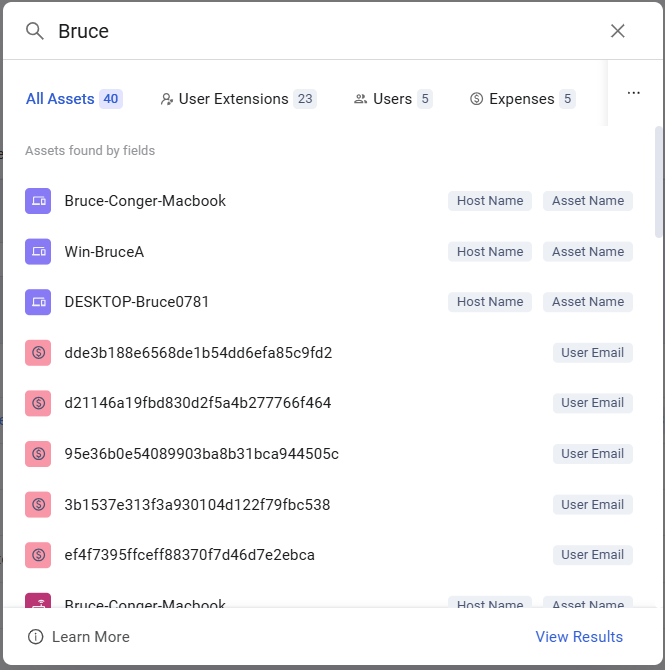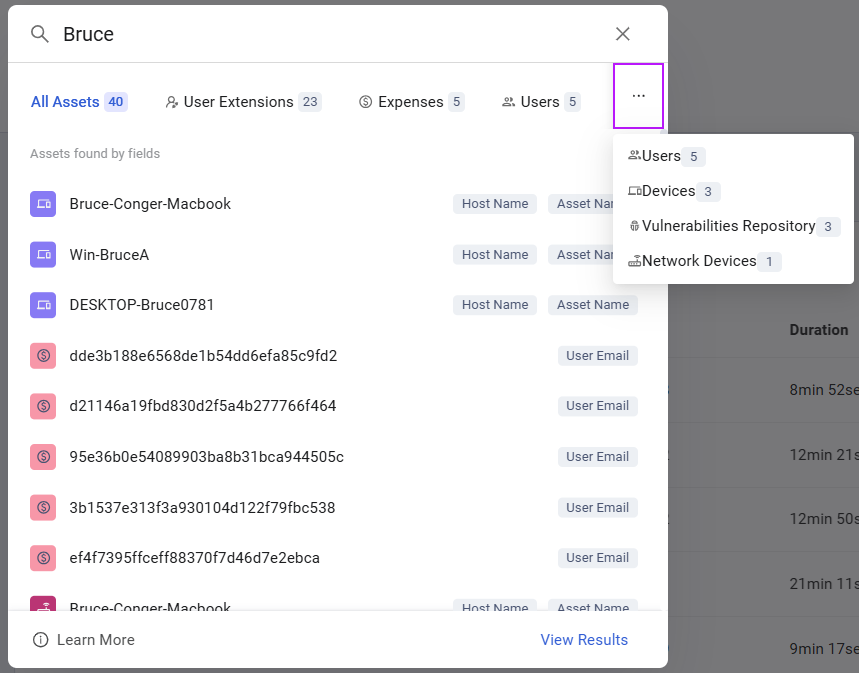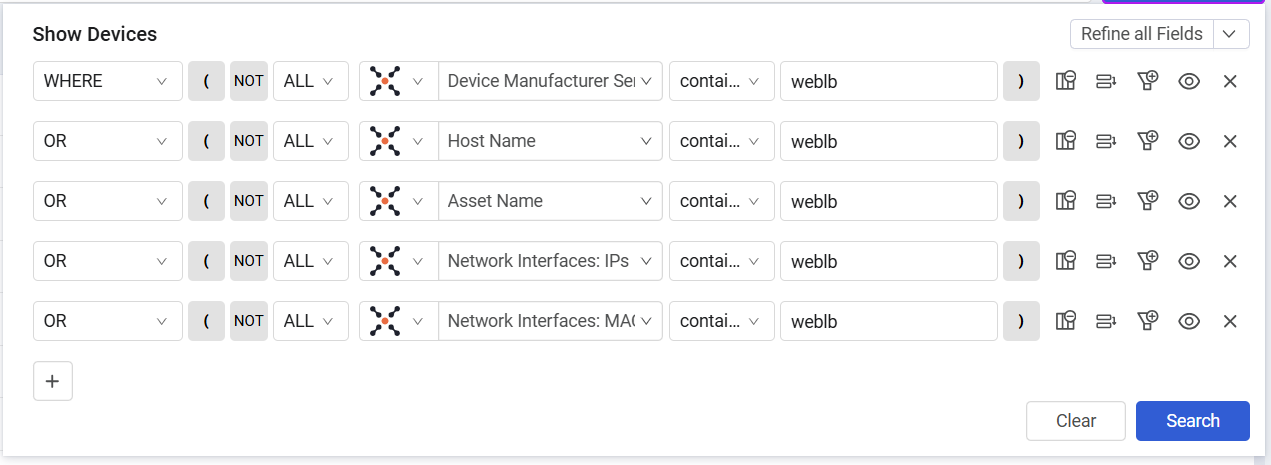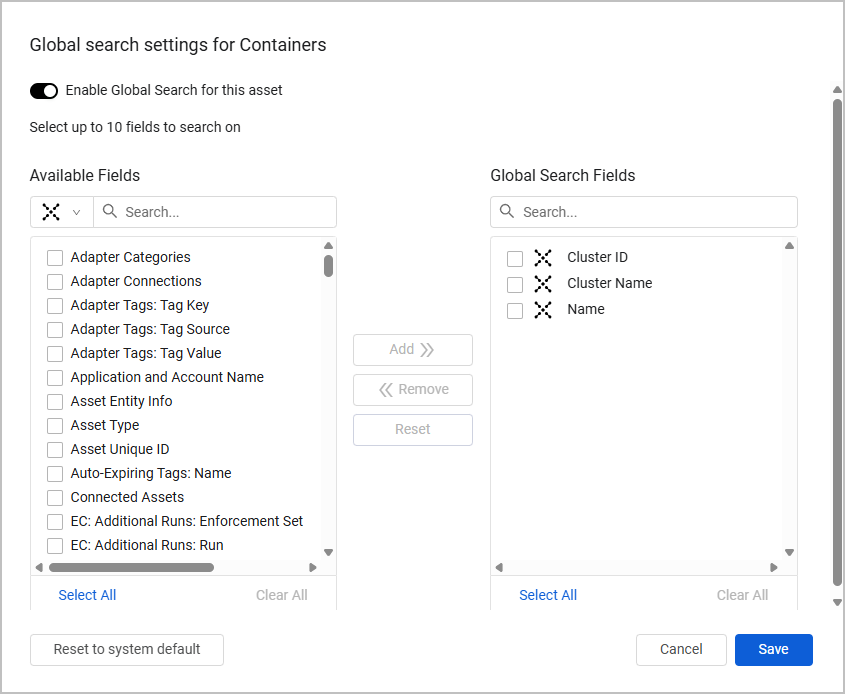Searching for Assets
Use the search bar to identify and investigate a specific asset or security misconfiguration (for example, vulnerabilities). The search bar appears at the top of every page in Axonius. Note that you can also use the Query Wizard to create granular queries to define a wide variety of filters, from which you can easily drill down to the assets that match the required search criteria.
In addition, you can add Axonius as a 'new' search engine in Google Chrome to search for assets in Axonius directly from the Google Chrome address bar. See Searching for Assets Directly from Google Chrome Address Bar for more information.
Searching for a Specific Asset
Upon entering free text into the search bar, the search runs on all asset types and the field names available for searching those assets. To learn which fields are searchable for each asset type, see Fields Available for Search.
Note
To run the search, you must be logged in to Axonius.
Click the search bar to open the Search Axonius dialog, or type Ctrl + Y for shortcut. The dialog contains two sections: Recently Searched assets and Recently Viewed assets (assets whose specific Asset Profile page was viewed). If this is your first search ever, these sections are empty.

After typing at least three characters in the search bar, a list of results instantly appears, and updates as you keep on typing.
Note
The Search function is not case-sensitive.
Under the search bar, you can see which asset types were found by the string you typed and how many of each asset type were found. Hover over the  icon to view additional asset types that were found. Click a specific asset type tab to view a list of only assets from this type.
icon to view additional asset types that were found. Click a specific asset type tab to view a list of only assets from this type.
The Asset found by fields section lists all search results.
In the following example, we searched for "Bruce" and found 40 assets in total, including the following asset types: User Extensions, Expenses, Users, Devices, Vulnerability Repository, and Network Devices. The fields found include Host Name, Asset Name, User Email, and more.


Hover over a record row to view the full fields values. In the following example, you can see that "Bruce" was found in Devices, and the full Host Name and Asset Name fields values in which it appears are displayed.

From the Search Axonius dialog, you can:
- Investigate a specific asset by clicking any record from the result list. This redirects you to the relevant Asset Profile page.
- View the detailed list of results and explore them in the Assets Pages by selecting View Results at the bottom right of the dialog. You can either select this option from the All Assets tab, in which case, the search results open at the Assets Page of the first asset type suggested; or select it from a specific asset type tab, in which case, the search results open at this specific type's Assets Page.
- Customize the search settings to define specific searchable fields for each asset type.
Viewing the List of Results
Select View Results to go to the Search Results For [Search Text] page. Use the left selection pane to navigate between the different Assets Pages in which results were found. In the following example, the Devices page displays all assets in which the string "weblb" was found and the fields it was found in. In this case, it was found in the Host Name and Asset Name fields.

In each Search Results page, your search is translated to a Query Wizard expression. The query includes all the fields that were searched with OR conditions between them. See for example the query from the example above:

Note that all default fields are added automatically to the query even if they did not return results. If results were found in fields that do not exist in your default view, those fields are automatically added to the table.
See the Assets Page documentation for information on additional actions you can perform on each Assets Page to manage the assets found, such as creating queries, editing the table columns, refining data, exporting data, and more.
To exit the search results and reset the current Assets Page to your default view, click Clear Search Results on the top right of the page. You can also do this by clicking Reset on top of the table.
Note
Once you click Clear Search Results, you cannot go back to the search page unless you click the search bar again and select it from the Recently Searched section.
To resume a search, if it appears in the Recently Searched section, click on it to run it again. Note that your last search is saved and can be accessed from the search bar from any page, unless you click X to reset it.
Customizing Global Search Settings
You can customize your Global Search settings per asset type as follows:
- Decide whether to exclude or include specific asset types in the Global Search. Global Search will not return results from excluded asset types.
- Change an asset type's default searchable fields by configuring up to 10 fields to search the asset by. This allows a more accurate search, tailored to your needs. Only string-type fields are supported for configuring.
Notes
- Only Admins can edit Global Search settings.
- When you edit the list of searchable fields for a selected asset type, it becomes manually managed, so that any change made to the list by Axonius (such as adding or removing default fields to search) will no longer apply. To change that, you can reset the list of searchable fields back to the Axonius default.
To edit search settings:
- From the Search Axonius dialog, select Settings.

- You are directed to System Settings
>Data>Global Search Fields. This page lists all asset types available for Global Search and which of their fields are searchable. The Last Update column indicates the last time the search settings of each asset type were manually updated. - Click on a row to open the Global search settings for [Asset Type Name] dialog.
- Toggle Enable Global Search for this asset on or off to include or exclude it from search results. This setting is enabled by default for most asset types.
- Editing searchable fields: on the left, all fields available for search are listed; on the right, all fields currently used for global search are listed. Select fields from the right to remove, or fields from the left to add. You can set up to 10 searchable fields.

- Click Save to save your changes, or Cancel to discard them. You can also click Reset to system default to reset the list of searchable fields to the Axonius default.
- After saving your changes, the Last Update column updates with the date and time of the changes.
Note
The changes made to the searchable fields list may take up to 6 hours to apply.
Searching for Assets Directly from Google Chrome Address Bar
Note
To run the search from Google Chrome, you must be already logged in to Axonius.
To enable searching for assets directly from Google Chrome, you need to add Axonius as a 'new' search engine in Google Chrome:
- On your computer, open Google Chrome.
- At the top right, click More (
.png) ) and then Settings.
) and then Settings. - Under Search engine, select Manage search engines and site search.
- Below the Search engines section, click Add.
- In the Add search engine dialog displayed, provide the following information:
a. Search engine - Enter a label or name for the search engine. For example: "Axonius".
b. Shortcut - Enter the text shortcut you want to use for the search engine. You can enter the shortcut in your address bar to quickly use the search engine. For example: "Axonius".
c. URL with %s in place of query - Use the following URL format:
https://[your Axonius address]/dashboard/explorer?search=%s - Select Add.
.png)
Note
For additional instructions, see Google Chrome Help -Add, edit, or remove other search engines.
To search for assets directly from Google Chrome, in the address bar, type "Axonius", press Tab or Space, and then type the text to search for. For example:
.png)
The Search page then opens, displaying the searched text in the search bar and the results for it.
Updated 4 days ago
